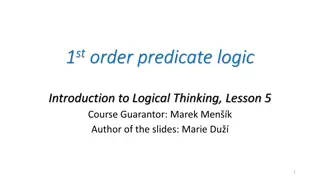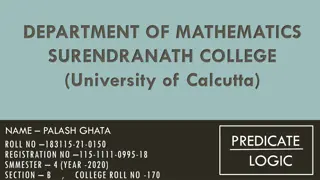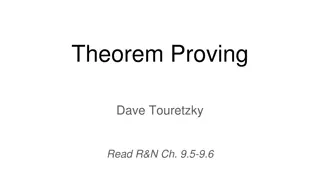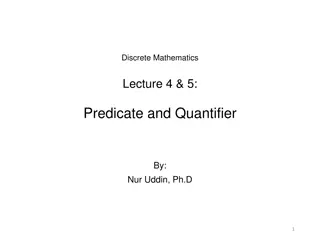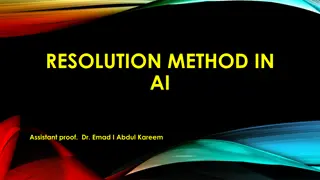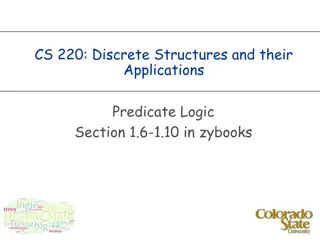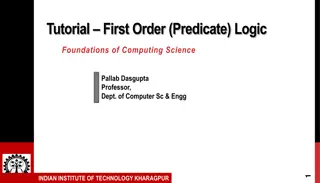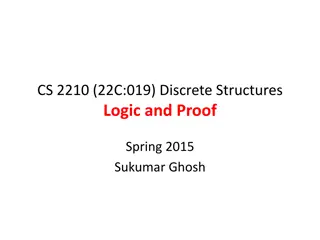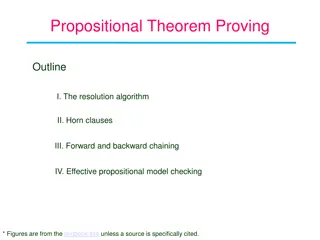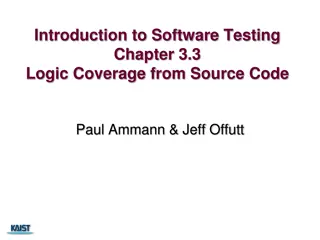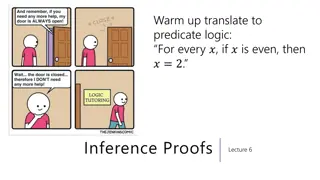Understanding Resolution Theorem Proving in Predicate Logic
Resolution theorem proving is a method used in predicate logic to find contradictions within a database of clauses. By negating statements and applying resolution rule of inference, it aims to show inconsistency to prove the original theorem. The process involves putting premises into clause form, adding negations of goals, resolving clauses, and generating empty clauses to reach contradictions.
Download Presentation

Please find below an Image/Link to download the presentation.
The content on the website is provided AS IS for your information and personal use only. It may not be sold, licensed, or shared on other websites without obtaining consent from the author. Download presentation by click this link. If you encounter any issues during the download, it is possible that the publisher has removed the file from their server.
E N D
Presentation Transcript
By Dr. Ismael AbdulSattar 1
Resolution Theorem Proving Resolution is the way of finding contradictions in a database of clauses with minimum use of substitution. Resolution refutation proves a theorem by negating the statement to be proved and adding this negated goal to the set of axioms that are known (have been assumed) to be true. It then uses the resolution rule of inference to show that this leads to a contradiction. Once the theorem prover shows that the negated goal is inconsistent with the given set of axioms, it follows that the original goal must be consistent. This proves the theorem. 2 C93734F252A1F5B0294E69D3A9A7AB8F
Predicate logic and quantifiers Resolution refutation proofs involve the following steps: 1. Put the premises or axioms into clause form. 2. Add the negation of what is to be proved, in clause form, to the set of axioms. 3. Resolve these clauses together, producing new clauses that logically follow from them. 4. Produce a contradiction by generating the empty clause. 5. The substitutions used to produce the empty clause are those under which the opposite of the negated goal (what was originally to be proven) is true. Artificial Intelligence : 21F744D3A06EFD3C1FC8DDF2F08A98BB 3
Resolution Refutations Producing the Clause Form for Resolution Refutations 1. First we eliminate the by using the equivalent form proved in Chapter 2: a b a b. This transformation reduces the expression in (i) above: Note the negation will not affect the quantifiers her because of brackets 4 C93734F252A1F5B0294E69D3A9A7AB8F
Predicate logic and quantifiers 2. Next we reduce the scope of negation. This may be accomplished using a number of the transformations like: Using the fourth equivalences (ii) becomes: 5 C93734F252A1F5B0294E69D3A9A7AB8F
Resolution Refutations 3. Next we standardize by renaming all variables so that variables bound by different quantifiers have unique names. Because variable names are dummies or place holders, the particular name chosen for a variable does not affect either the truth value or the generality of the clause. Transformations used at this step are of the form: Because (iii) has two instances of the variable X, we rename: 6 C93734F252A1F5B0294E69D3A9A7AB8F
Resolution Refutations 4. Move all quantifiers to the left without changing their order. This is possible because step 3 has removed the possibility of any conflict between variable names. (iv) now becomes: After step 4 the clause is said to be in prenex normal form, because all the quantifiers are in front as a prefix and the expression or matrix follows after. 7 C93734F252A1F5B0294E69D3A9A7AB8F
Resolution Refutations At this point all existential quantifiers are eliminated by a process called skolemization. where the name fido is picked from the domain of definition of X to represent that individual X. fido is called a skolem constant. If the predicate has more than one argument and the existentially quantified variable is within the scope of universally quantified variables, the existential variable must be a function of those other variables. This is represented in the skolemization process: 8 C93734F252A1F5B0294E69D3A9A7AB8F
Resolution Refutations is skolemized to: Now,Replacing Y with the skolem function f(X) and Z with g(X), (v) becomes: 9 C93734F252A1F5B0294E69D3A9A7AB8F
Resolution Refutations 6. Drop all universal quantification. By this point only universally quantified variables exist (step 5) with no variable conflicts (step 3). Formula (vi) now becomes: 10 C93734F252A1F5B0294E69D3A9A7AB8F
Resolution Refutations 7. Next we convert the expression to the conjunct of disjuncts form. This requires using the associative and distributive properties of and . Recall a (b c) = (a b) c a (b c) = (a b) c which indicates that or may be grouped in any desired fashion. The distributive property is also used, when necessary. Because a (b c) is already in clause form, is not distributed. However, must be distributed across using: a (b c) = (a b) (a c) The final form of (vii) is: 11 C93734F252A1F5B0294E69D3A9A7AB8F
Resolution Refutations 8. Now call each conjunct a separate clause. In the example (viii) above there are two clauses: 9. The final step is to standardize the variables apart again. This requires giving the variable in each clause generated by step 8 different names. 12 C93734F252A1F5B0294E69D3A9A7AB8F
Binary Resolution Proof Procedure The resolution refutation proof procedure answers a query or deduces a new result by reducing a set of clauses to a contradiction, represented by the null clause ( ). The contradiction is produced by resolving pairs of clauses from the database. If a resolution does not produce a contradiction directly, then the clause produced by the resolution, the resolvent, is added to the database of clauses and the process continues. 13 C93734F252A1F5B0294E69D3A9A7AB8F
Binary Resolution Proof Procedure Example: We wish to prove that Fido will die from the statements that Fido is a dog and all dogs are animals and all animals will die. Changing these three premises to predicates gives: Fido is a dog: dog (fido). All dogs are animals: (X) (dog (X) animal (X)). All animals will die: (Y) (animal (Y) die (Y)). converts these predicates to clause form: 14 C93734F252A1F5B0294E69D3A9A7AB8F
Binary Resolution Proof Procedure PREDICATE FORM CLAUSE FORM dog (fido) dog (fido) dog (X) animal (X) (X) (dog) (X) animal (X)) animal (Y) die (Y) (Y) (animal (Y) die (Y)) Negate the conclusion that Fido will die: die (fido) Resolve clauses having opposite literals, producing new clauses by resolution as in Figure .This process is often called clashing. die (fido) 15 C93734F252A1F5B0294E69D3A9A7AB8F
Binary Resolution Proof Procedure Figure 1: Resolution proof for the "dead dog" problem. C93734F252A1F5B0294E69D3A9A7AB8F 16
Binary Resolution Proof Procedure Example 2: We now present an example of a resolution refutation for the predicate calculus. Consider the following story of the happy student : Anyone passing his history exams and winning the lottery is happy. But anyone who studies or is lucky can pass all his exams. John did not study but he is lucky. Anyone who is lucky wins the lottery. Is John happy? 17 C93734F252A1F5B0294E69D3A9A7AB8F
Binary Resolution Proof Procedure First Change The Sentences To Predicate Form: 1) Anyone passing his history exams and winning the lottery is happy. X (pass (X,history) win (X,lottery) happy (X)) 2) Anyone who studies or is lucky can pass all his exams. X Y (study (X) lucky (X) pass (X,Y)) 3) John did not study but he is lucky. study (john) lucky (john) 4) Anyone who is lucky wins the lottery. X (lucky (X) win (X,lottery)) 18 C93734F252A1F5B0294E69D3A9A7AB8F
Binary Resolution Proof Procedure 1. pass (X, history) win (X, lottery) happy (X) 2. study (Y) pass (Y, Z) 3. lucky (W) pass (W, V) 4. study (john) 5. lucky (john) 6. lucky (U) win (U, lottery) Into these clauses is entered, in clause form, the negation of the conclusion: 7. happy (john) Second changed to clause form 19 C93734F252A1F5B0294E69D3A9A7AB8F
Binary Resolution Proof Procedure 20 C93734F252A1F5B0294E69D3A9A7AB8F
Binary Resolution Proof Procedure Example3: As a final example in this subsection we present the exciting life problem; suppose: All people who are not poor and are smart are happy. Those people who read are not stupid. John can read and is wealthy. Happy people have exciting lives. Can anyone be found with an exciting life? 21 C93734F252A1F5B0294E69D3A9A7AB8F
Binary Resolution Proof Procedure First change the sentences to predicate form: We assume X (smart (X) stupid (X)) and Y (wealthy (Y) poor (Y)), and get: X ( poor (X) smart (X) happy (X)) Y (read (Y) smart (Y)) read (john) poor (john) Z (happy (Z) exciting (Z)) The negation of the conclusion is: W (exciting (W)) 22 C93734F252A1F5B0294E69D3A9A7AB8F
Binary Resolution Proof Procedure Second changed to clause form poor (X) smart (X) happy (X) read (Y) smart (Y) read (john) poor (john) happy (Z) exciting (Z) exciting (W) 23 C93734F252A1F5B0294E69D3A9A7AB8F
Binary Resolution Proof Procedure 24 C93734F252A1F5B0294E69D3A9A7AB8F



